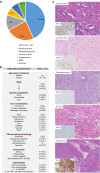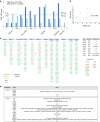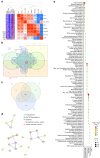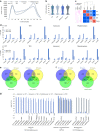Characterizing the mutational burden, DNA methylation landscape, and proteome of germ cell tumor-related somatic-type malignancies to identify the tissue-of-origin, mechanisms of therapy resistance, and druggable targets
- PMID: 37726478
- PMCID: PMC10645790
- DOI: 10.1038/s41416-023-02425-5
Characterizing the mutational burden, DNA methylation landscape, and proteome of germ cell tumor-related somatic-type malignancies to identify the tissue-of-origin, mechanisms of therapy resistance, and druggable targets
Abstract
Background: Germ cell tumors (GCT) might undergo transformation into a somatic-type malignancy (STM), resulting in a cell fate switch to tumors usually found in somatic tissues, such as rhabdomyosarcomas or adenocarcinomas. STM is associated with a poor prognosis, but the molecular and epigenetic mechanisms triggering STM are still enigmatic, the tissue-of-origin is under debate and biomarkers are lacking.
Methods: To address these questions, we characterized a unique cohort of STM tissues on mutational, epigenetic and protein level using modern and high-throughput methods like TSO assays, 850k DNA methylation arrays and mass spectrometry.
Results and conclusions: For the first time, we show that based on DNA methylation and proteome data carcinoma-related STM more closely resemble yolk-sac tumors, while sarcoma-related STM resemble teratoma. STM harbor mutations in FGF signaling factors (FGF6/23, FGFR1/4) highlighting the corresponding pathway as a therapeutic target. Furthermore, STM utilize signaling pathways, like AKT, FGF, MAPK, and WNT to mediate molecular functions coping with oxidative stress, toxin transport, DNA helicase activity, apoptosis and the cell cycle. Collectively, these data might explain the high therapy resistance of STM. Finally, we identified putative novel biomarkers secreted by STM, like EFEMP1, MIF, and DNA methylation at specific CpG dinucleotides.
© 2023. The Author(s).
Conflict of interest statement
The authors declare no competing interests.
Figures





Similar articles
-
Targeting CLDN6 in germ cell tumors by an antibody-drug-conjugate and studying therapy resistance of yolk-sac tumors to identify and screen specific therapeutic options.Mol Med. 2023 Mar 29;29(1):40. doi: 10.1186/s10020-023-00636-3. Mol Med. 2023. PMID: 36991316 Free PMC article.
-
Germ cell tumors of the gonads: a selective review emphasizing problems in differential diagnosis, newly appreciated, and controversial issues.Mod Pathol. 2005 Feb;18 Suppl 2:S61-79. doi: 10.1038/modpathol.3800310. Mod Pathol. 2005. PMID: 15761467 Review.
-
Neuroendocrine carcinoma in a mediastinal teratoma as a rare variant of somatic-type malignancy.Virchows Arch. 2013 Nov;463(5):731-5. doi: 10.1007/s00428-013-1476-3. Epub 2013 Aug 25. Virchows Arch. 2013. PMID: 23979407
-
Genome wide DNA methylation profiles provide clues to the origin and pathogenesis of germ cell tumors.PLoS One. 2015 Apr 10;10(4):e0122146. doi: 10.1371/journal.pone.0122146. eCollection 2015. PLoS One. 2015. PMID: 25859847 Free PMC article.
-
Testicular Tumors: A Contemporary Update on Morphologic, Immunohistochemical and Molecular Features.Adv Anat Pathol. 2021 Jul 1;28(4):258-275. doi: 10.1097/PAP.0000000000000302. Adv Anat Pathol. 2021. PMID: 33871428 Review.
Cited by
-
Role of Epigenetics for the Efficacy of Cisplatin.Int J Mol Sci. 2024 Jan 17;25(2):1130. doi: 10.3390/ijms25021130. Int J Mol Sci. 2024. PMID: 38256203 Free PMC article. Review.
-
Induction of SOX17 with stimulation of WNT, TGF-beta, and FGF signaling drives embryonal carcinomas into the yolk-sac tumor lineage resulting in increased cisplatin resistance.Int J Cancer. 2025 Jun 1;156(11):2210-2224. doi: 10.1002/ijc.35385. Epub 2025 Mar 2. Int J Cancer. 2025. PMID: 40025812 Free PMC article.
-
MicroRNA-371-373 cluster and methylome analysis suggests that a subset of 'somatic-type' malignancies arising in germ cell tumors may originate in yolk sac tumor components.J Pathol. 2025 Jun;266(2):160-176. doi: 10.1002/path.6412. Epub 2025 Mar 28. J Pathol. 2025. PMID: 40152072 Free PMC article.
-
Engineered heart muscle allografts for heart repair in primates and humans.Nature. 2025 Mar;639(8054):503-511. doi: 10.1038/s41586-024-08463-0. Epub 2025 Jan 29. Nature. 2025. PMID: 39880949 Free PMC article.
-
Analysis of GATA3 and FOXA2 expression suggests that downregulation of genes involved in the maintenance of a mature yolk sac tumor phenotype may underlie sarcomatoid transformation.Virchows Arch. 2024 Apr;484(4):709-713. doi: 10.1007/s00428-023-03725-0. Epub 2023 Dec 23. Virchows Arch. 2024. PMID: 38141134
References
-
- Cheng L, Albers P, Berney DM, Feldman DR, Daugaard G, Gilligan T, et al. Testicular cancer. Nat Rev Dis Prim. 2018;4:1–24. - PubMed
Publication types
MeSH terms
Substances
Grants and funding
LinkOut - more resources
Full Text Sources
Molecular Biology Databases
Miscellaneous

